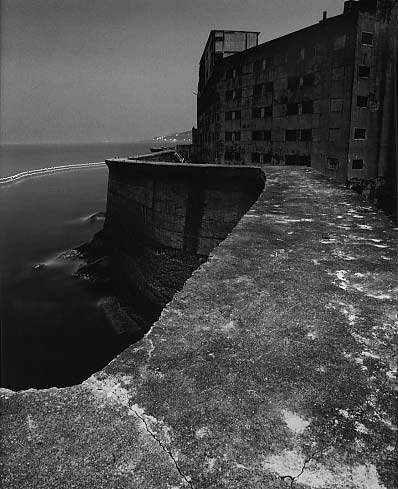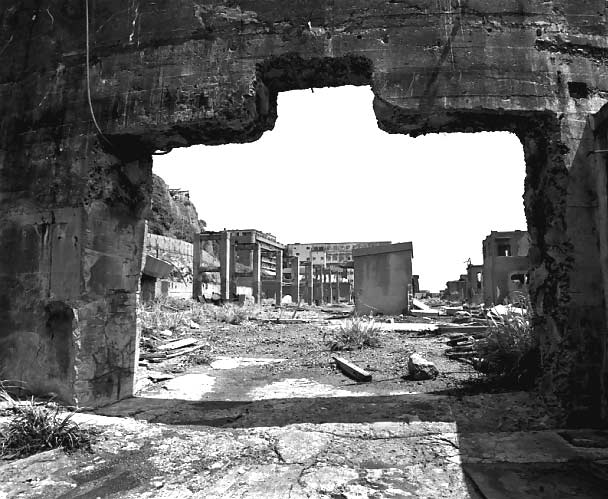Gunkanjima Island
 [Image: Gunkanjima Island (via)].
[Image: Gunkanjima Island (via)]."Off the westernmost coast of Japan, is an island called 'Gunkanjima' that is hardly known even to the Japanese. Long ago, the island was nothing more than a small reef. Then in 1810, [with] the chance discovery of coal ... people came to live here, and through coal mining the reef started to expand continuously. Befor [sic] long, the reef had grown into an artificial island of one kilometer (three quarters of a mile) in perimeter, with a population of 5300. Looming above the ocean, it appeared a concrete labyrinth of many-storied apartment houses and mining structures built closely together.



 [Images: Gunkanjima Island (via)].
[Images: Gunkanjima Island (via)].Seen from the ocean, the silhouette of the island closely resembled a battleship – so, the island came to be called Gunkanjima, or Battleship Island."
 [Image: Gunkanjima Island (via)].
[Image: Gunkanjima Island (via)].The idea of an entirely artificial mining island seems to lie somewhere between James Bond and Greek mythology. I've always wanted to write a short story about a mineral-rich island where a man similar to Conrad's Kurtz sets up a mining operation; in mining the mineral wealth of his new little island, the architecture and structural engineering – the gantries, vaults, platforms, roads, etc. – come to be built from the island itself. Eventually the island entirely disappears beneath the waterline, mined down to nothing – and yet a small stilt-city of mining platforms, engineering decks, control rooms, and cantilevered walkways still exists there, built from the island it all now replaces.
In The Scar by China Miéville, there's a floating city made from tightly lashed-together hulls of ships, built so densely that, for those deep within it, it appears simply to be a particularly over-built – albeit floating – island. The rudders and keels of old boats cut through the water at angles contrary to the direction that the ship-island floats in, and thousands of anchors secure the city in place when it needs to find harbor.
What seems to be missing, at least to my experience, from architectural history & design courses are things like – drum roll – offshore mining derricks. Once again, it seems the wrong people are teaching our design labs: instead of more M.Arch grads who've read too much – or not enough – Deleuze, we need to bring in junior executives from BP or Halliburton, geologists and NASA engineers, and put them into dialogue with Situationism – and, why not, with China Miéville. Science fiction writers. Get ideas out of the one side, practical engineering science out of the other, and shebang...
What could that produce...? is a legitimate question. A terrible example, but still marginally interesting I think, would be something like the Burning Man festival, thrown not in the desert but in the middle of the Atlantic Ocean. A joint-venture between BP, Halliburton, and Peter Cook of Archigram. And the Mars Homestead Project. Seaborne utopias. Platform cities. Perhaps Atlantis was built by a battalion of rogue Roman engineers lost to history.
 [Image: Gunkanjima Island (via)].
[Image: Gunkanjima Island (via)].It's not Damien Hirst, Daniel Libeskind, Matthew Barney, or Norman Foster we should be watching, neither artistically nor architecturally, I mean; it's the Chief Operating Officers of offshore oil-services firms. The architectural patrons of today are not avant-garde, middle class Connecticut home-owners but logistical managers in the US Department of Energy. New building types are not being discovered or invented in the design labs of American architectural offices, but in the flowcharts and budgetary projection worksheets of multinational petrochemical firms. Forget Spiral Jetty – we need a platform city built above the mid-Atlantic rift, an uninhabited, reinforced concrete archipelago ideal for untrained astronomical observation. The Reef Foundation – you win their residency grant and get to spend six months alone staring at the sun on a perfectly calibrated Quikrete lily pad.
We need the wastrel sons of hedge fund billionaires out there patronizing manmade archipelagos in the South China Sea.
We need more Gunkanjima Islands.
 [Image: Gunkanjima Island (via)].
[Image: Gunkanjima Island (via)].





Comments are moderated.
If it's not spam, it will appear here shortly!
On this subject it's worth recommending the work of Helen and Hard (http://www.hha.no/) whose recycling projects in Stangeland in Norway forsee a kind of venetian fantasy of platforms, islands and jettys made through the reuse of platforms, infrastructure, etc from the oil industry, spanning the fjords and harbours.
Cool – I'll check it out. Thanks!
"something like the Burning Man festival", "A joint-venture between BP, Halliburton" In the same sentence?!!! (actually the next sentence but still.) Only you can pull off something like that.
You can look at the Island in Google Earth.
This is a great entry, but if you can, get the DVD from Amazon.co.jp. Full color and in stereo. Faaaaaaaantastic. Great for straight viewing or wow 'em at parties by putting it on in the background.
Here's a video of the island:
http://vids.myspace.com/index.cfm?fuseaction=vids.individual&videoid=1535826104
pictures of gunkanjima in 2007
軍艦島 by louis cyprien rials
Pictures i took at Gunkanjima 5-6 June 2007.
I don't know if you realised Geoff but the buildings that comprise Gunkanjima represent some of the first attempts in Japan to build reinforced concrete high rise residential and other buildings. It was literally a testing ground for new building technology in Japan.
Some Engineering Professors from the Tokyo Denki University compiled a remarkable book where they detail the construction of almost every building on the island, plan views, drawings and photographs: http://tinyurl.com/r5dkhm
For 10 years after the island was first abandoned they took their students with them on a yearly excursion as they investigated the ways in which the buildings were crumbling over time and under the often severe environmental conditions:
http://tinyurl.com/o2el83
Currently the Nagasaki City council, who have been trying to come up with a way to see some return on the site for years (they even considered covering the island with strings of lights so they could light it up like a christmas tree), are planning to construct a viewing platform on a corner of the island where people who have paid up for a boat tour can get a closer look.
This is some great footage of the island from above:
http://tinyurl.com/qtpa68
The trips to Gunkanjima are operational. The platform was being built in 2008 when I went there. Entering beyond the platform is still of limits, but access from the back of the island, in the dark is still possible.
If interested you can see more pictures here:
http://www.smithjan.com/hashima.html
Now with it's own Google Maps tour... Then again I am writing this eight years later
Post a Comment